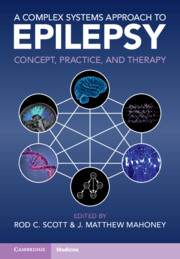Book contents
- A Complex Systems Approach to Epilepsy
- A Complex Systems Approach to Epilepsy
- Copyright page
- Contents
- Contributors
- Chapter 1 Introduction
- Chapter 2 Systems Biology Approaches to the Genetic Complexity of Epilepsy
- Chapter 3 Transcriptomic and Epigenomic Approaches for Epilepsy
- Chapter 4 Phenomenological Mesoscopic Models for Seizure Activity
- Chapter 5 Personalized Network Modeling in Epilepsy
- Chapter 6 The Baseline and Epileptiform EEG
- Chapter 7 Neuronal Approaches to Epilepsy
- Chapter 8 Mapping Epileptic Networks with Scalp and Invasive EEG
- Chapter 9 A Neuroimaging Network-Level Approach to Drug-Resistant Epilepsy
- Chapter 10 Epilepsy as a Complex Network Disorder
- Index
- References
Chapter 9 - A Neuroimaging Network-Level Approach to Drug-Resistant Epilepsy
Published online by Cambridge University Press: 06 January 2023
- A Complex Systems Approach to Epilepsy
- A Complex Systems Approach to Epilepsy
- Copyright page
- Contents
- Contributors
- Chapter 1 Introduction
- Chapter 2 Systems Biology Approaches to the Genetic Complexity of Epilepsy
- Chapter 3 Transcriptomic and Epigenomic Approaches for Epilepsy
- Chapter 4 Phenomenological Mesoscopic Models for Seizure Activity
- Chapter 5 Personalized Network Modeling in Epilepsy
- Chapter 6 The Baseline and Epileptiform EEG
- Chapter 7 Neuronal Approaches to Epilepsy
- Chapter 8 Mapping Epileptic Networks with Scalp and Invasive EEG
- Chapter 9 A Neuroimaging Network-Level Approach to Drug-Resistant Epilepsy
- Chapter 10 Epilepsy as a Complex Network Disorder
- Index
- References
Summary
Epilepsy affects approximately 1% of the population [1]. Although generally treatable, up to 30% of patients do not achieve seizure freedom from anticonvulsive medication alone. Due to its relationship with cognitive abilities [2], quality of life [3], and the associated risk of premature death [4], drug-refractory epilepsy should be treated promptly. Temporal lobe epilepsy (TLE) associated with mesiotemporal sclerosis [5] and extra-temporal lobe epilepsy related to focal cortical dysplasia (FCD) [6] constitute the most common refractory epilepsy syndromes. Surgical resection of these lesions remains the treatment of choice [7], with success rates approaching 80% [8]. By allowing the detection of epileptogenic lesions and offering system-level mechanisms of the disease process, MRI has shifted the field from electro-clinical correlations toward a multidisciplinary approach.
- Type
- Chapter
- Information
- A Complex Systems Approach to EpilepsyConcept, Practice, and Therapy, pp. 127 - 134Publisher: Cambridge University PressPrint publication year: 2023



